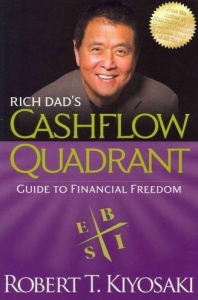“Never depend on a single income. Make investments to create a second source.” – Warren Buffett
Shortly after reading Kiyosaki’s “Cashflow Quadrant“; I had an abrupt wakeup call.
It seemed that even though I am a “self-employed” practice owner, I’m nothing more than a glorified employee (trading time for money).
In other words, if Dr. Jeff ain’t treating patients, no money is being deposited.
You can imagine my disappointment when this “realization” hit me and I started in with all of the “Buts” such as:
- But… I OWN a practice.
- But…I have employees working for me.
- But…I sign the checks!
Well, I guess the joke was on me. Although owning a business was originally a dream of mine, it STILL requires me to be present in order for revenue to be produced.
Kiyosaki’s book opened my eyes to the fact that HOW you earn MONEY was as important as HOW much money you earn.
Reread that sentence until it sinks in.
After dental school, I always thought it was all about making the most money you can. I’ve quickly learned that the way I’m earning money (self-employed), put me in the HIGHEST tax category there is.
It seems that instead of always focusing on making more, I should start focusing on earning the right way by working smarter.
The straw that broke the Camel’s back (there’s always one of those, right) seemed to have happened during a fall while skiing. My hands were bent backwards causing a minor wrist injury which more importantly exposed my “risky” way of living.
As a dental surgeon, without the use of my hands, I’d be out of business and unemployed.
Up until that point of my career, I had only one income stream (dental practice) to provide for the family. I’d once heard that the worst number in business was “one” and now I was realizing how much that was true.
If you go through your entire career relying on only one income stream, that’s an accident waiting to happen. Literally.
If this sounds like your situation then good news, I have the exact solution just for you….
Don’t Miss Any Updates. Each week I’ll send you advice on how to reach financial independence with passive income from real estate.
Sign up for my newsletterWhat is a Real Estate Syndication?
The concept of a real estate syndication is not difficult to grasp especially if you’ve ever played poker.
In a syndication, you’re throwing money into a “pot” with others with the difference being in poker, you’re trying to win the entire pot.
In a syndication, you’re able to split the pot with the other players (investors) in a deal including the dealer (syndicator).
This “pot” of money is used to purchase property (apartment buildings, hotels, self-storage facilities, etc.) and hold for an extended period of time.
By “joining forces” with other investors, this type of investing becomes a team sport where everyone wins.
“Why haven’t I heard about these types of investments before?”
New Passive Investors Circle members frequently ask this question that are new to the real estate investing game.
In the past, only those that fell under the wealthy individual investor category had access to these types of deals.
But ever since the JOBS Act was passed, it has allowed the accredited investor access to passive real estate syndicators.
Before we get into how a real estate syndicate works, let’s take a look at who’s involved in the process.
Basics Of Real Estate Syndication
One of the best ways to learn something new is by using an analogy (which is how Jesus taught in the Bible).
So when I get the question, “Jeff, how does a real estate syndication work?”, I typically will compare it to traveling on an airplane.
There are several groups of people involved such as:
- pilots
- passengers
- flight attendants
- mechanics
- luggage and ground crew
Using this analogy, the deal sponsor of a syndication are the pilots and you and I (passive investors) represent the passengers.
Even though both groups are traveling to the same destination, each have considerably different roles during the process.
If surprises occur such as unexpected weather conditions or engine problems, it’s the pilots who are responsible for the flight.
They’re the ones who will monitor and update the passengers during the flight:
(“Good afternoon, this is your captain speaking. We’ve hit an area of turbulence but should be through it shortly….”).
And it’s the passengers job to sit back and allow the pilots to make the decisions on what’s best to flying the plane.
Make sense?
“90% of millionaires become so through owning real estate.” – Andrew Carnegie
Hopefully you now get a gist of what’s involved during this process as real estate syndication deals works much the same way.
There’s several groups of people that all share a vision and want to improve a particular asset such as:
- Sponsor (general partner)
- Passive investors (limited partners)
- Brokers
- Property management
However, each person’s role within the project is different.
Let’s take a look at the two main groups involved:
#1 General Partner (GPs)
They’re also known as the sponsor group and typically:
- find the deal(s)
- get it under contract
- arrange inspections
- evaluate the numbers
- obtain financing
- keep it leased
- manage the property
#2 Limited Partner (LPs)
This group is made up of those that choose to invest passively with limited risk.
Remember, they have no active responsibilities in managing the asset.
How Can You Profit From a Real Estate Syndication?
Now that you understand the basic operation of how a syndication works, let’s discuss how you can profit from investing in this type of deal.
Profit in any type of real estate opportunities, regardless of a syndication or not, comes from:
- rental income
- appreciation
Profit is generated when the operating costs of the property are LESS than the rents collected.
This is known as the NOI or net operating income which represents the cash flow distributed to the limited partners via distributions (monthly or quarterly).
Investors will receive an additional benefit as typically a property’s value usually appreciates over time. Because of this, the investors can net higher rents and earn larger profits when the property is sold.
Syndication example
In order to drive this concept home, let’s use an example.
Let’s say that you’ve been researching about the syndication process via blogs and then you come across this GREAT YouTube channel 🙂 and decide to jump in and invest.
A group buys a 350-unit apartment complex in Charlotte, NC for the purchase price of $50 million.
Everything you need to know is outlined in the Private Placement Memorandum (PPM) which you read BEFORE investing.
You learn that the bank financing the deal requires a 30% down payment ($15M). Of this amount, the sponsors cover $1.5M and then they raise money from limited partners (LPs) for the remaining $13.5 million of the required equity.
A syndication is now formed (Limited Liability Company or LLC) between the general partners and limited partners and the apartment complex is purchased.
The projected hold time for this project was initially set forth at 5 years. During this time period, the business plan including “forced appreciation” as it was a value-add deal.
Related article: 3 Reasons Value Add Real Estate Investing Can Work For You
Improvements to the property were made such as:
- upgraded fixtures
- new flooring
- granite countertops
- stainless steel appliances
- new cabinets
- new signage
- update fitness center
- rehab existing pool
- parking lot upgrades
- painting (interior and exterior)
- new landscaping
- internet and wifi update
During this time period improvements were being made, the rents were gradually raised to the same amounts being charged by other local apartments with the same amenities.
Due to the increased rental income, the syndication sends the passive investors a share of the profits from the rental properties every quarter. (Profit #1 rental income)
After five years, a buyer is found and the complex is sold for $15 million ($65M) over the original sales price.
At this time, the limited partners get back their initial investment plus a share of the $15 million profit from the sale. (Profit #2 appreciation)
Remember, during this five year hold period, all of the passive investors received distributions on a quarterly basis from the profit made with the rental income.
Types Of Real Estate Syndication
There are several asset classes that you can invest in within a syndication such as:
- multifamily properties
- self-storage
- manufactured home parks
- land development
- hotels
- student housing
- medical office buildings
As a busy professional with two teenagers, I tend to be a bit more risk averse. For this reason, I focus mostly (not exclusively) on assets that are already stabilized with a proven track record for cash flow.
The returns may not be as large versus a new development but the risk tends to be lower.
What’s The Investing Process?
The next logical question you’re probably asking yourself is, “How do I invest?”
Here are the steps for getting into the syndication game.
- The sponsor sends out a “deal offering” email that an investment is open.
- Review the offering memorandum (property description) and make an investment decision.
- Submit the amount you want to invest to the sponsor.
- The sponsor holds an investor webinar, where you can get more information and ask questions.
- The sponsor confirms your spot in the limited partnership and sends you the PPM (private placement memorandum).
- Fund the deal via wire or check.
- The sponsor confirms that your funds have been received.
- You’ll receive a notification once the deal closes and what to expect next.
How To Find a Sponsor You Can Trust
As you can imagine, I get this question quite often, “Jeff, how can I find a real estate sponsor that I can trust with my money?”
Not a bad question to ask.
Here’s 7 steps that you can take in order to evaluate a sponsor:
#1 Track record
The first recommendations when evaluating a potential sponsor is evaluating their experience or track record.
Potential questions to ask:
- How many deals have you closed?
- How many deals have you exited?
If this is the first time to invest, it would be wise to choose a more experienced sponsor that has had several deals go “full cycle“.
This means that they have property that was purchased in the past go through the hold period and then eventually sell.
#2 Background check
If this is the first time to vet a new sponsor, it would be a good idea to have a background check performed.
These can usually be found on either a podcast interview or articles they’ve submitted online to real estate sites.
You can also go directly to their website to find out their:
- investment philosophy
- acquisition criteria
- portfolio of previous projects
After performing these steps and you want to continue moving forward, it’s now time to set up a call with the group. The goal is to get to know them more on a personal level before deciding to invest.
#3 Cycle experience
It’s important that a sponsor has experience with all four phases of an economic cycle which are:
- recovery phase
- expansion phase
- hyper supply phase
- recession phase
Your goal is to evaluate whether or not they faced challenges such as going through a recession phase.
This is also your chance to ask them about their previous failures, how they handled them, and what they’re doing to mitigate those risks moving forward.
The main thing we want to understand is exactly what happened and what they did about it to prevent future issues.
#4 Risk evaluation
Typically, syndications are marketed are hassle-free or worry-free but there’s no such thing as a real estate investing being risk-free.
Each deal carries some degree of risk.

Most experienced sponsors typically:
- are forthcoming about any risks
- will discuss how they can impact the property
- inform you about the steps needed to help minimize them
#5 Communication
When I first started investing in real estate in 2016, seasoned investors made it a point to tell me how good their “communication” was between the sponsors they invested with and their investors.
Having good, consistent communication is imperative especially for the new investor that has yet to establish a relationship with a sponsor.
The sponsor should communicate potential risks in the:
- anticipated timeline
- transaction
- business plan
- fees
- underwriting assumptions
After the deal closes, sponsors should continue regular communication with their investors to keep them updated on the:
- distribution schedule
- renovations occurring
#6 Tax reduction strategies
One of the primary benefits of investing in real estate is its favorable tax treatment.
It’s imperative that the sponsor has a thorough understanding of the different tax benefits and uses strategies such as:
- performing a cost segregation study for each project
- takes advantage of accelerated depreciation
#7 Has skin in the game
If the sponsor truly “believes” in their deal, then they should have “sweat equity” or “skin in the game“.
This means that they are using their own capital into the deal.
If they don’t believe in their deal enough to put up money, you shouldn’t either.
Where To Find Syndication Opportunities
I can’t stress this next point enough….the MOST IMPORTANT part of any syndication investment is NOT the:
- deal
- returns
- whatever a website tells you
The MOST IMPORTANT part is the SPONSOR.
They’re the ones that know how to find the best deals as it’s their job to.
Unfortunately, I see too many busy professionals (i.e. doctors) thinking they can continue to practice full-time yet want to get into the syndication business themselves.
I thought about this too UNTIL I realized the amount of support you must have from a team of professionals to make these deals work.
I work with groups that have dedicated people to:
- source and find deals
- underwrite deals
- obtain inspections
- get financing for the project
- manage properties
- and much more
As you can see from the list above, if you plan on syndicating a deal yourself, it’s next to impossible to have a full time job. Something is going to have to give.
If you’re interested in finding deals to invest in then start by networking with other investors. This can be through meet ups, meetings, etc.
The internet is another great way to begin the search process.
If you’re too busy for either of those and would like to know what I personally invest in and have the opportunity to invest along side me, join the Passive Investors Circle below….
Join the Passive Investors Circle









